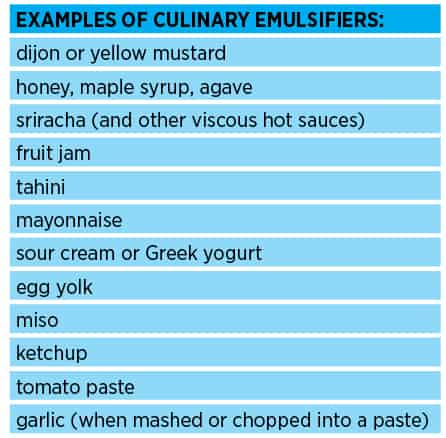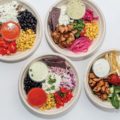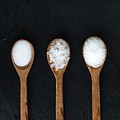Share this Post

Never in history have people been so willing to overpay for a salad as they are today. Places like Happy + Hale, Cava and Chopt funnel hordes of yuppies and yogis alike through assembly lines of lettuce and accoutrements for upwards of 12 bucks a pop—and I have to admit—part of me gets it. They’re tasty, they’re filling, they’re low-carb, you eat them with one of those green compostable forks that resurrects a dead sea turtle every time you throw one out—they’re great. But, at $12 each visit, I just can’t justify the habit.
Do the math: One salad three days a week equals $144 per month. That’s not a salad budget, it’s internet plus utilities. Fortunately, with a little knowledge and effort, you can surprise yourself and your family with an endless variety of top-notch salads of your own creative inspiration.
A Template for Successful Salads
Most salads follow a simple formula: a bed of leafy greens or grains is topped or tossed with something creamy, something crunchy, something juicy, something sweet and/or savory, and a dynamic dressing that ties the flavor profile together. It’s easy to thoughtfully assemble a salad to fit this format. The dressing, however, requires a little more finesse and know-how.

The Case Against Store-Bought
You might be wondering: Why would I make my own salad dressing when the supermarket has everything I could possibly think of? It’s a fair question—I think the brand Ken’s alone makes 500 different types of Italian dressing. Making your own may seem like a fool’s errand: These companies specialize in salad dressing. Why would I compete with that?
Next time you’re in the salad dressing aisle, turn one of those bottles around. Most contain cheap ingredients like soybean oil and distilled vinegar, followed by a list of Walter White-level chemistry terms. Pretty ironic to dump that on top of a salad—the paradigm of health food.
Making your own salad dressing puts you in control of the ingredients. That means you can make Italian dressing out of Italian products—and skip the chemistry set.
Dress for the Salad You Want
Classically, a vinaigrette is made of one part vinegar to two or three parts oil, depending on the vinegar’s intensity. Considering vinegar is 95 percent water and the fact that oil prefers to float on water than mix into it, this formula proves problematic.
Contrary to popular belief, oil—not vinegar—wilts greens to create soggy salads. A two-ingredient salad dressing separates quickly, causing the vinegar to drip to the bottom of the bowl while the oil wreaks havoc on the leaves. Fortunately, there are ways to delay oil and vinegar’s separation for long enough to eat the salad—or even indefinitely.
When I make a salad dressing, I usually mix vinegar with a few emulsifiers before gradually whisking in oil. Emulsifiers—or surfactants—are molecules that are both hydrophilic and lipophilic, meaning they attract both water and fat, and therefore aid in the seemingly impossible task of stabilizing a mixture of oil and vinegar.
There are a handful of common culinary products that are rich in emulsifiers, and I recommend relying on them heavily. Emulsifying a dressing improves its texture—making it feel creamy, rather than wet or oily.

Building a Vinaigrette
I usually make vinaigrettes in a small mixing bowl on top of a wet paper towel so it doesn’t slide around during whisking.
Start with vinegar: The amount of vinegar you start with will be about a quarter of the total dressing you’ll produce, depending on how much flavoring, emulsifiers and oil you use. I usually happen to make extra—which is okay, since dressings generally improve after a day or two of flavor-melding in the fridge. Do yourself a favor and save old pickle jars or buy some plastic squeeze bottles to house your arsenal of homemade dressings.
Balance your flavor base: After you select your vinegar (or vinegars), choose add-ins that build on the desired flavor profile—mustard, honey, hot sauce, etc. Generally speaking, I try to include something sweet, something spicy, some chopped up herb, and 99 percent of the time—garlic.
If you can, use emulsifiers or other viscous ingredients. It ultimately helps form the emulsion if your flavor base (before adding oil) has the texture of a thin paste that can coat the back of a spoon. If your base is too thin but you like its flavor, add a squeeze of mayo—which has a relatively neutral flavor—to up the consistency.
Whisk in oil: While whisking vigorously, gradually drizzle in oil, cutting the flow occasionally to make sure it’s all getting absorbed before continuing to add more. I usually use extra virgin olive oil, unless I am going for an Asian flavor profile. Simply stop when you like the texture and flavor.
Seasoning: When adding salt to your dressing, you may want to add a little more than you think. You’re not just seasoning the dressing—you’re seasoning all the ingredients in the salad.
Pantry Staple Italian Dressing

This recipe is composed of ingredients that most people already have on hand, making it a great go-to utility dressing that is both simple and impressive.
Yield: about 1 cup of dressing
Ingredients:
¼ cup red wine vinegar (50 grams)
1 tbsp dijon mustard (17 grams)
1 tbsp honey (17 grams)
1 tbsp Duke’s Mayo (14 grams)
2 tsp Texas Pete (or your favorite hot sauce) (10 grams)
½ tsp Worcestershire sauce (2.5 grams)
1 big clove of garlic, crushed and minced into a paste (9 grams)
1 tsp Italian seasoning or ½ tsp each dry oregano and basil
½ cup extra virgin olive oil (100 grams)
2 tsp kosher salt (about 8 grams), plus more in the salad to taste
Pepper to taste
Process:
- Place a small mixing bowl on a damp paper towel to prevent sliding.
- Whisk together all ingredients except the oil until homogenous.
- While whisking vigorously, slowly drizzle in the oil. If the oil starts pooling, stop pouring, whisk harder, and make sure everything’s integrated before resuming.
- If desired, add more salt and pepper to taste.
In this series, local chef Bobby McFarland offers tips on how to cook like the pros. Currently the lead culinary consultant at The Kitchen Raleigh, McFarland loves eating pomegranate, cheese and all things pork. His culinary hero is Alton Brown.
Share this Post









Comments
Perfect Plus is a concierge of event services that include Birthdays, Getaways. Proposals, Wedding Planning. We also organize accommodation, catering, chauffeur service, photography, and videography. You can experience a variety of thrills all while we capture you with 4k cinematography, drone technology, and more. We have a wide range of clientele and partners globally, you can rest assured you are getting the best services at a reasonable price.